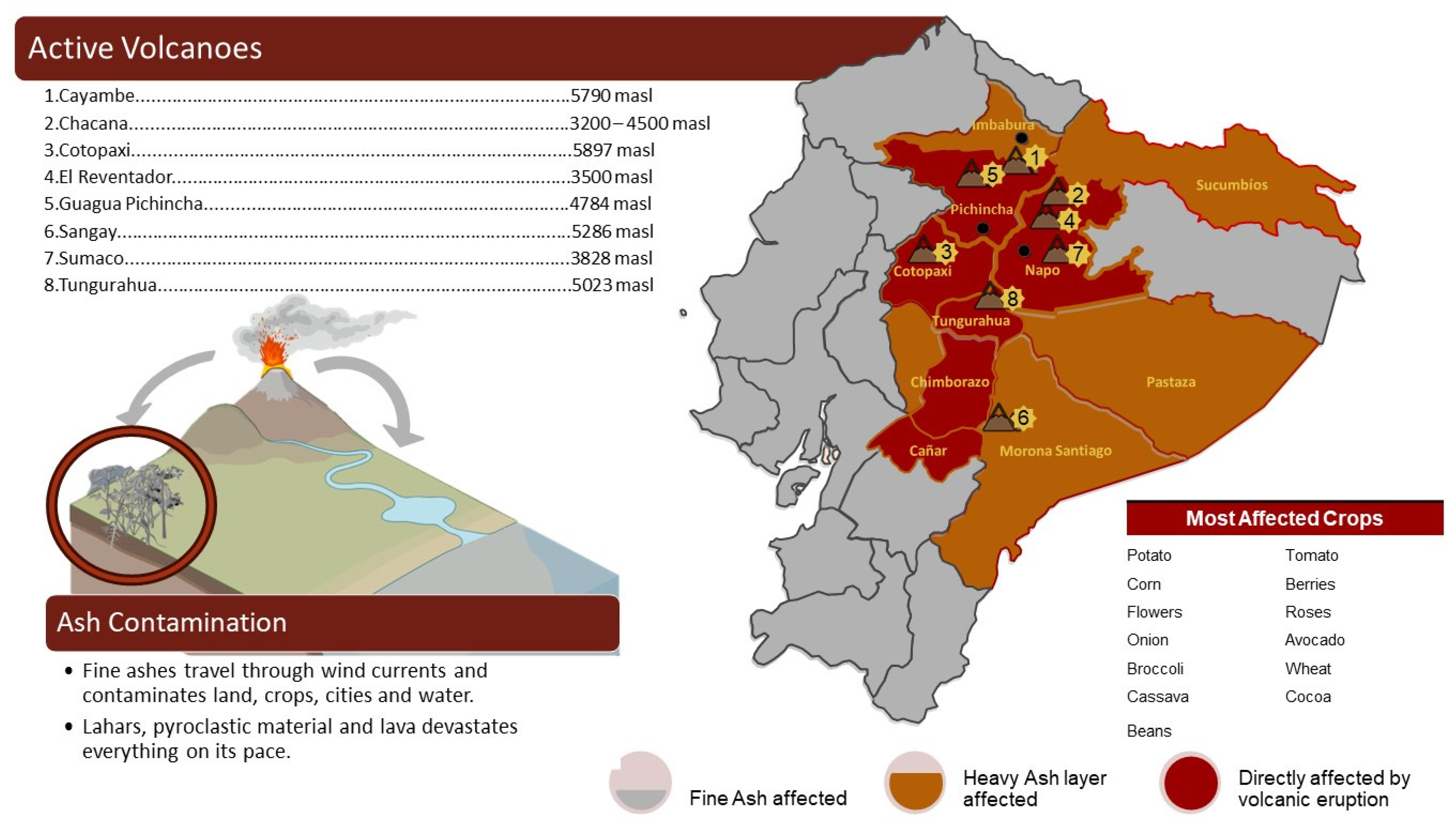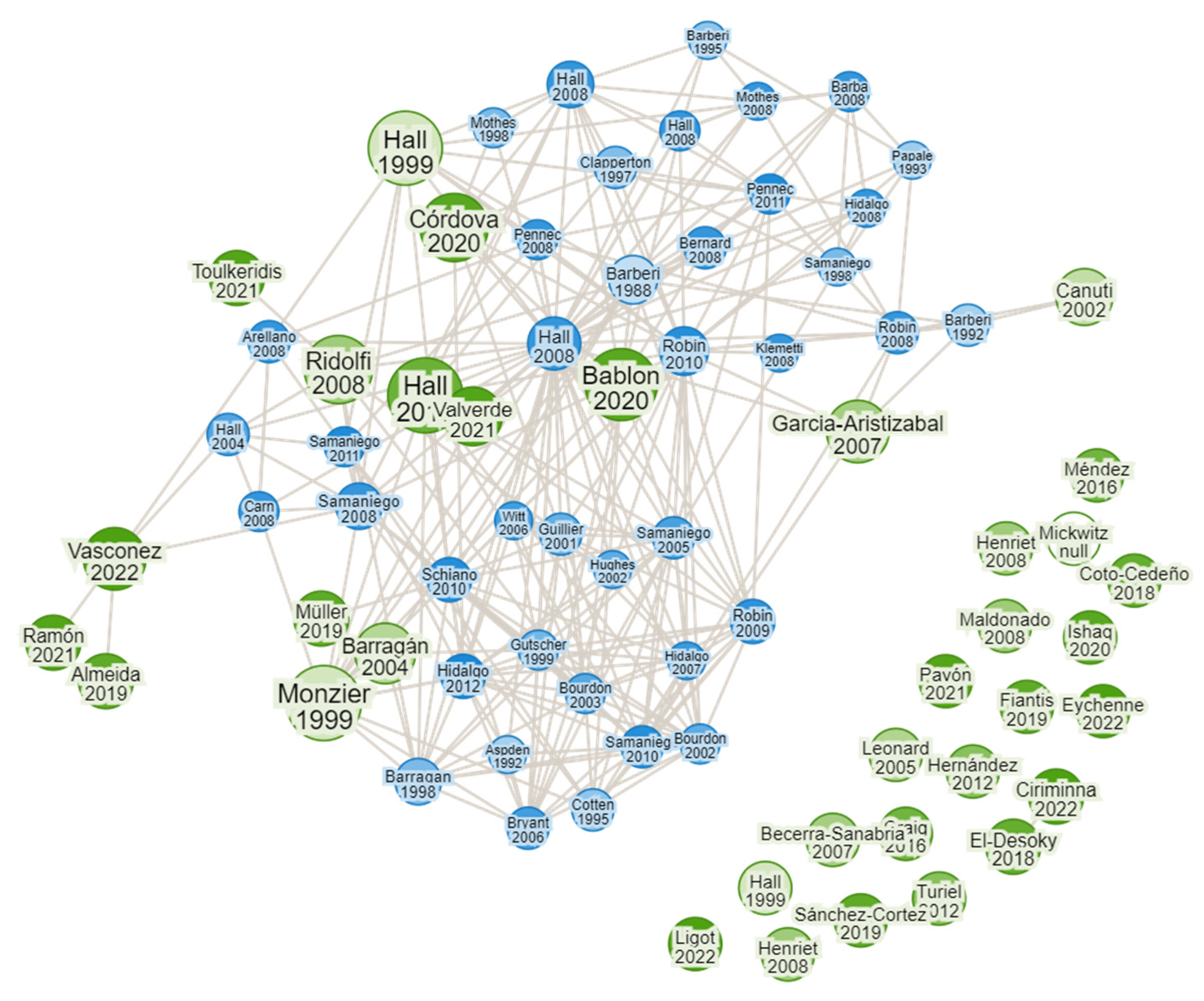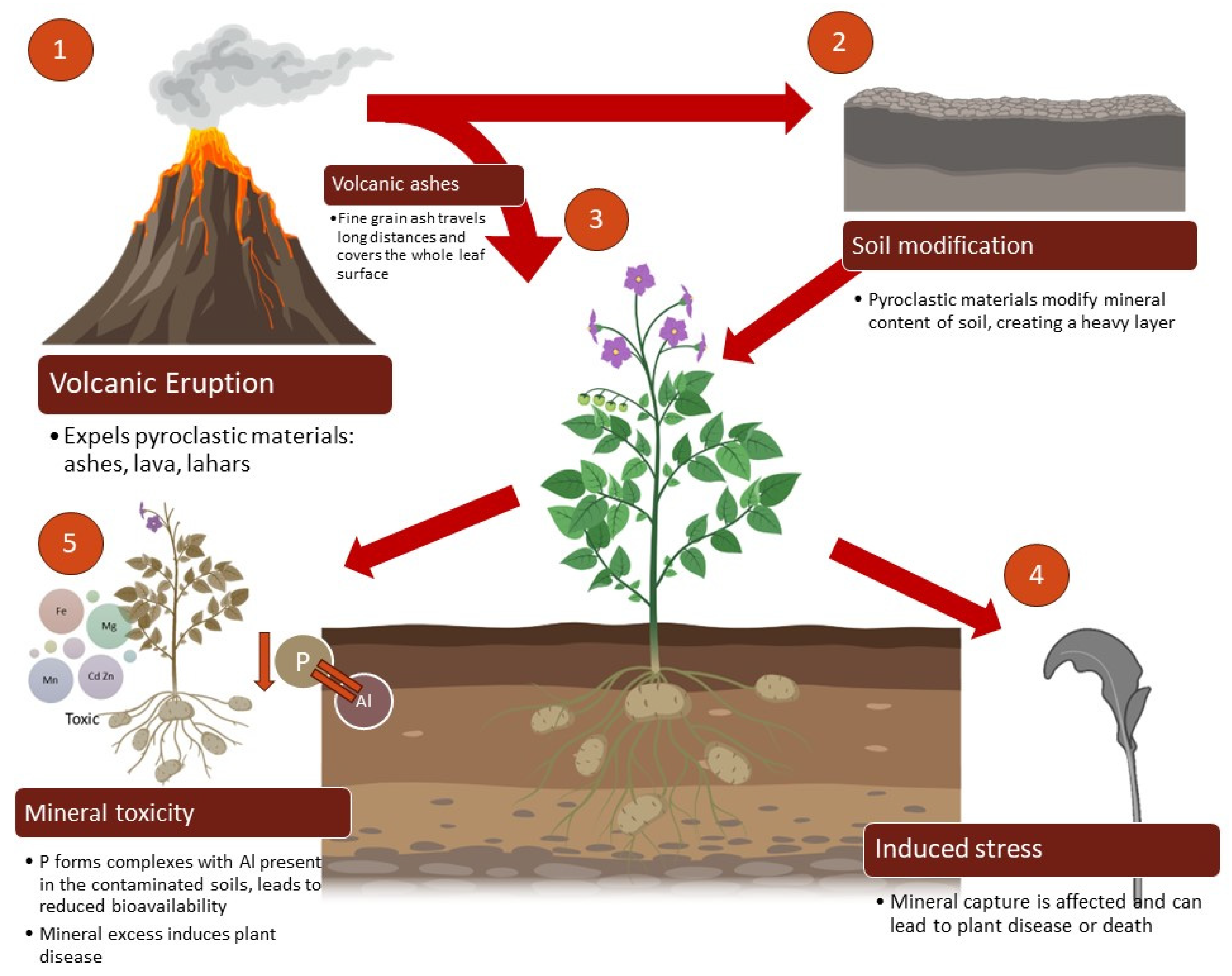Does the Mineral Composition of Volcanic Ashes Have a Beneficial or Detrimental Impact on the Soils and Cultivated Crops of Ecuador?
Abstract
:1. Introduction
- Extinct or dormant if their last eruption occurred during the Pleistocene.
- Active for volcanoes that last erupted during the Holocene. This includes volcanoes that erupted during historical time (since 1532, the time of the Spanish Conquest).
- Erupting for volcanoes that are currently erupting or whose last eruption occurred in the last two years (e.g., 2018–2020) [9].
2. Overview of the Subject in the Literature
3. Volcanic Material Composition from Different Volcanoes
- pyroclastic flows (deposits of volcanic ash, pumice stone, and rock fragments);
- lahars with deposits 5 to 10 m thick; and
- the transport of volcanic material by means of the wind, reaching thousands of square kilometers [11].
4. Volcanic Ash, a Boost for the Soil Nutrition of Ecuadorian Crops
5. Majorly Affected Crops Cultivated in Ecuador
5.1. Oil Palm (Elaeis guineensis L.)
5.2. Coffee (Coffea spp.)
5.3. Plantain or Banana (Musa spp.)
5.4. Potato (Solanum tuberosum L.)
6. Effect of Mineral Toxicity on Agriculture
6.1. Arsenic
6.2. Nitrogen
6.3. Phosphorus
6.4. Potassium
6.5. Fluorine
6.6. Sulfur
6.7. Iron
7. Conclusions
Author Contributions
Funding
Institutional Review Board Statement
Informed Consent Statement
Data Availability Statement
Acknowledgments
Conflicts of Interest
References
- Sánchez, J.L. Conservation of geoheritage in Ecuador: Situation and perspectives. Int. J. Geoherit. Parks 2019, 7, 91–101. [Google Scholar] [CrossRef]
- Barragán, R.; Baby, P. Evolución magmática actual de la zona subandina: Volcanes El Reventador y Sumaco, modelos geodinámicos preliminares. In La Cuenca Oriente: Geología y Petróleo; Rivadeneira, M., Ed.; Institut Français d’Études Andines: Qioto, Ecuador, 2015; pp. 183–201. [Google Scholar] [CrossRef]
- Toulkeridis, T.; Seqqat, R.; Torres Arias, M.; Salazar-Martinez, R.; Ortiz-Prado, E.; Chunga, S.; Vizuete, K.; Heredia, R.M.; Debut, A. Volcanic Ash as a Precursor for SARS-CoV-2 Infection among Susceptible Populations in Ecuador: A Satellite Imaging and Excess Mortality-Based Analysis. Disaster Med. Public Health Prep. 2021, 16, 2499–2511. [Google Scholar] [CrossRef] [PubMed]
- Coto-Cedeño, W.I. Nubes de ceniza, campos de arena. Actividad volcánica en Costa Rica y su impacto en el sector agropecuario, 1950–2017. Rev. Geográfica América Cent. 2018, 1, 98. [Google Scholar] [CrossRef]
- Haro-Haro, A. Evaluación del Impacto Ambiental en los Pastizales Producidos por el Proceso Eruptivo del Volcán Tungurahua en la Hacienda Choglontus [Escuela Superior Politécnica del Chimborazo]. 2011. Available online: //dspace.espoch.edu.ec/bitstream/123456789/1020/1/17T01045.pdf (accessed on 23 May 2023).
- Alfaro, J. El Impacto de la Ceniza en los Pequeños Productores Agrícolas y Ganaderos. En Torno a la Prevención 2023. 28. Available online: http://revistaentorno.desastres.hn/pdf/spa/doc2803/doc2803-contenido.pdf (accessed on 12 July 2023).
- González, R.; Dec, D.; Valle, S.; Zúñiga, F.; Dörner, J. Efecto de cenizas volcánicas del Cordón Caulle sobre parámetros de calidad física en suelos agrícolas del sur de Chile. Agro Sur 2015, 43, 53–63. [Google Scholar] [CrossRef]
- González, M.; Garzón, M.; Álvarez, C.; Laich, F. Efecto de la Aplicación de Ceniza Volcánica en Suelos Sobre la Salud del Suelo en el Cultivo de Platanera. 2022. Available online: https://www.icia.es/icia/download/noticias/Informe_Evaluación_Finca_AGUSA.pdf (accessed on 12 July 2023).
- Ramon, P.; Vallejo, S.; Monthes, P.; Andrade, D.; Vásconez, F.; Yepes, H.; Hidalgo, S.; Santamaría, S. Instituto Geofísico—Escuela Politécnica Nacional, the Ecuadorian Seismology and Volcanology Service. Volcanica 2021, 4 (Suppl. S1), 93–112. [Google Scholar] [CrossRef]
- Fernández-Turiel, J.L.; Saavedra-Alonso, J.; Ruggieri, F.; Gimeno-Torrente, D.; Perez-Torrado, F.J.; Rodriguez-Gonzalez, A.; Martínez, L.D.; Gil, R.; García-Vallés, M.; Polanco, E.; et al. Geoquímica de cenizas volcánicas a lo largo de dos transectas en Sudamérica: Implicaciones ambientales. Geo-Temas 2012, 13, 2–5. [Google Scholar]
- Molina-Cuchipe, T. Análisis Comparativo de las Cenizas Volcánicas Provenientes de los Volcanes Cotopaxi, Pululahua, Chalupas, Guagua Pichincha y Tungurahua para Su Uso en la Fabricación de Concreto [Escuela Politécnica Nacional]. 2021. Available online: https://bibdigital.epn.edu.ec/bitstream/15000/21675/1/CD11155.pdf (accessed on 23 May 2023).
- Córdova, M.D.; Mothes, P.A.; Gaunt, H.E.; Salgado, J. Post-Caldera Eruptions at Chalupas Caldera, Ecuador: Determining the Timing of Lava Dome Collapse, Hummock Emplacement and Dome Rejuvenation. Front. Earth Sci. 2020, 8, 1–21. [Google Scholar] [CrossRef]
- Pavón Cevallos, F.M.; Contreras, D. Análisis estadístico de simulaciones numéricas de dispersión y caída de ceniza del volcán Cayambe para la determinación de afectación en el sector florícola, Cantón Cayambe, Ecuador. Rev. Cart. 2021, 104, 63–86. [Google Scholar] [CrossRef]
- IGEPN. Mapa de Peligros Potenciales del Volcán Cayambe. Instituto Geofísico EPN. 2022. Available online: https://www.igepn.edu.ec/mapas/amenaza-volcanica/mapa-volcan-cayambe.html (accessed on 13 May 2023).
- Bablon, M.; Quidelleur, X.; Siani, G.; Samaniego, P.; Le Pennec, J.-L.; Nouet, J.; Liorzou, C.; Santamaría, S.; Hidalgo, S. Glass shard K-Ar dating of the Chalupas caldera major eruption: Main Pleistocene stratigraphic marker of the Ecuadorian volcanic arc. Quat. Geochronol. 2020, 57, 101053. [Google Scholar] [CrossRef]
- Andrade Ayala, N.A.; Daza Donoso, P.J. Estimación de la Carga viva por Caída de Ceniza en las Zonas Susceptibles de los Volcanes Cotopaxi, Guagua Pichincha, Reventador y Tungurahua y Comparación con la Norma Ecuatoriana de la Construcción (NEC-SE-CG) [Trabajo De Titulación, Previo a La Obtención DEL Título DE Ingeniera Civil]; Pontificia Universidad Católica del Ecuador: Quito, Ecuador, 2022. [Google Scholar]
- Aguilera-Ortíz, E.; Toulkeridis, T. El Volcán Cotopaxi, una Amenaza Que Acecha; Agencia Suiza para el Desarrollo y la Cooperación—COSUDE: Bern, Switzerland, 2005. [Google Scholar] [CrossRef]
- Vásconez, F.; Moussallam, Y.; Bani, P.; Battaglia, J.; Hidalgo, S.; Benbakkar, M.; Harris, A.; Narváez, D. Ash and gas discharge during open vent activity at El Reventador (Ecuador): Explosion-style transitions driven by conduit capping. Bull. Volcanol. 2022, 84, 77. [Google Scholar] [CrossRef]
- Ridolfi, F.; Puerini, M.; Renzulli, A.; Menna, M.; Toulkeridis, T. The magmatic feeding system of El Reventador volcano (Sub-Andean zone, Ecuador) is constrained by texture, mineralogy and thermobarometry of the 2002 erupted products. J. Volcanol. Geothermal. Res. 2008, 176, 94–106. [Google Scholar] [CrossRef]
- Zilbert, L.; Wiñches-Chaux, G.; Orrego, J. Volcán el Reventador una Comunidad Campesina Conviviendo con el Volcán el Reventador: Vol. Experiencia 8 (Primera Edición). Sandra Zuñiga Briceño. 2005. Available online: http://bvpad.indeci.gob.pe/doc/pdf/esp/doc303/ (accessed on 3 June 2023).
- Canuti, P.; Casagli, N.; Catani, F.; Falorni, G. Modeling of the Guagua Pichincha volcano (Ecuador) lahars. Phys. Chem. Earth Parts A/B/C 2002, 27, 1587–1599. [Google Scholar] [CrossRef]
- Hall, M.L.; Mothes, P.A.; Samaniego, P.; Militzer, A.; Beate, B.; Ramón, P.; Robin, C. Antisana volcano: A representative andesitic volcano of the eastern cordillera of Ecuador: Petrography, chemistry, tephra and glacial stratigraphy. J. South Am. Earth Sci. 2017, 73, 50–64. [Google Scholar] [CrossRef]
- Monzier, M.; Robin, C.; Samaniego, P.; Hall, M.L.; Cotten, J.; Mothes, P.; Arnaud, N. Sangay volcano, Ecuador: Structural development, present activity and petrology. J. Volcanol. Geothermal. Res. 1999, 90, 49–79. [Google Scholar] [CrossRef]
- Eychenne, J.; Gurioli, L.; Damby, D.; Belville, C.; Schiavi, F.; Marceau, G.; Szczepaniak, C.; Blavignac, C.; Laumonier, M.; Gardés, E.; et al. Spatial Distribution and Physicochemical Properties of Respirable Volcanic Ash from the 16–17 August 2006 Tungurahua Eruption (Ecuador), and Alveolar Epithelium Response In-Vitro. GeoHealth 2022, 6, e2022GH000680. [Google Scholar] [CrossRef]
- Müller, D.; Kueppers, U.; Hess, K.U.; Song, W.; Dingwell, D.B. Mineralogical and thermal characterization of a volcanic ash: Implications for turbine interaction. J. Volcanol. Geothermal. Res. 2019, 377, 43–52. [Google Scholar] [CrossRef]
- BBC News Mundo. Ecuador: La Ceniza del Tungurahua Afecta a Cinco Provincias. BBC News Mundo. 2 February 2014. Available online: https://www.bbc.com/mundo/ultimas_noticias/2014/02/140202_ultnot_ecuador_tungurahua_cenizas_lav (accessed on 3 May 2023).
- Jaramillo-Ochoa, F. Análisis Vulcanológico de la Hoya de Guayllabamba [Universidad Central del Ecuador]. 2021. Available online: http://www.dspace.uce.edu.ec/bitstream/25000/17303/1/T-UCE-0010-FIL-230.pdf (accessed on 3 May 2023).
- Toulkeridis, T. Chalupas: Un súper-volcán ecuatoriano que amenaza a todo el planeta. Rev. Cienc. Segur. Def. 2016, 1, 1–8. Available online: http://geo1.espe.edu.ec/wp-content/uploads/2016/07/art10.pdf (accessed on 3 May 2023).
- Becerra, L.; Navia, S.; Ñustez, C. Efecto de niveles de fosforo y potasio sobre el rendimiento del cultivar “Criolla Guaneña” en el departamento de Nariño. Rev. Asoc. Latinoam. Papa 2007, 14, 51–60. [Google Scholar]
- Fiantis, D.; Ginting, F.I.; Gusnidar, N.M.; Minasny, B. Volcanic Ash, Insecurity for the People but Securing Fertile Soil for the Future. Sustainability 2019, 11, 3072. [Google Scholar] [CrossRef]
- Ciriminna, R.; Scurria, A.; Tizza, G.; Pagliaro, M. Volcanic ash as multi-nutrient mineral fertilizer: Science and early applications. JSFA Rep. 2022, 2, 528–534. [Google Scholar] [CrossRef]
- El-Desoky, A.; Hassan, A.; Mahmoud, A. Volcanic Ash as a Material for Soil Conditioner and Fertility. J. Soil Sci. Agric. Eng. 2018, 9, 491–495. [Google Scholar] [CrossRef]
- Gobierno Autónomo Descentralizado de la Provincia de Pichincha. Agropecuario Agenda Productiva Provincial Capitulo V. En Gobierno De Pichincha Eficiencia y Solidaridad. Gobierno Autónomo Descentralizado de la Provincia Pichincha. 2010. Available online: http://sitp.pichincha.gob.ec/repositorio/diseno_paginas/archivos/app_libro_2_%20agropecuario.pdf (accessed on 28 July 2023).
- Oil Palm from Cosmetics to Biodiesel Colonization Lives on. 2006 NOVIB (The Netherlands), the Swedish Society for Nature Conservation (SSNC) and Rel-UITA (Latin American Regional Secretariat). Available online: https://www.wrm.org.uy//wp-content/uploads/2013/02/Palm2.pdf (accessed on 3 May 2023).
- Bravo, Z.J.M. Caracterización de la Cadenas de Producción e Industrialización de la Caña de Azúcar en la Provincia de Cotopaxi. Universidad Técnica de Cotopaxi. 2018. Available online: https://www.utc.edu.ec/INVESTIGACI%C3%93N/PROYECTOS-EJECUCION/CA%C3%91A-DE-AZ%C3%9ACAR (accessed on 28 July 2023).
- Méndez, Y.R. La Toxicidad por Aluminio (Al3+) Como Limitante del Crecimiento y la Productividad Agrícola: El caso de la Palma de Aceite. 2016. Available online: https://publicaciones.fedepalma.org/index.php/palmas/article/view/11696 (accessed on 3 May 2023).
- Méndez, R.Y.; Chacón, M.L.; Hernan, R. Response of the roots of oil palm O×G interspecific hybrids (Elaeis oleifera × Elaeis guineensis) to aluminum (Al3+) toxicity. Australian J Crop Sci 2014, 8, 1526–1533. [Google Scholar]
- Arcilla, J.; Saldías, C. La Erupción del Volcán Ilamatepec y su Efecto Sobre el Cultivo de Café [Diapositivas]. Republica de el Salvador. Available online: https://www.cenicafe.org/es/documents/Evaluacion_efectos_erupcion_El_Salvador2005.pdf (accessed on 24 June 2023).
- Steele, A. Por Qué se Cultiva Café Cerca de Volcanes Activos? Perfect Daily Grind Español. 2020. Available online: https://perfectdailygrind.com/es/2020/08/12/por-que-se-cultiva-cafe-cerca-de-volcanes-activos/ (accessed on 24 June 2023).
- Patricia. Efecto de las Cenizas Volcánicas en el Banano—BANABIO S.A. 2021. Available online: https://www.banabiosa.com/es/efecto-cenizas-volcanicas-en-el-banano/ (accessed on 24 June 2023).
- Henriet, C.; Bodarwé, L.; Dorel, M.; Draye, X.; Delvaux, B. Leaf silicon content in banana (Musa spp.) reveals the weathering stage of volcanic ash soils in Guadeloupe. Plant Soil 2008, 313, 71–82. [Google Scholar] [CrossRef]
- Jácome, E. Evaluación del Impacto de la Ceniza Volcánica Emitida por el Volcán Tungurahua, Sobre los Suelos Destinados a la Explotación Agrícola (Cantón Quero); [Tesis en Opción al Grado Científico de Magister en Gestión de la Producción]; Universidad Técnica de Cotopaxi: Latacunga, Ecuador, 2011. [Google Scholar]
- Hernández, H.; Forero, F.; Otálora, D.; Serrano, P. Respuesta agroeconómica del cultivo de papa (Solanum tuberosum L.) bajo diferentes fuentes de fósforo, en Villapinzón, Cundinamarca. Cienc. Agric. 2012, 9, 97–104. [Google Scholar]
- Leonard, G.; Johnston, D.M.; Williams, S.; Cole, J.W.; Finnis, K.; Barnard, S. Impacts and Management of Recent Volcanic Eruptions in Ecuador: Lessons for New Zealand; Institute of Geological & Nuclear Sciences: Lower Hutt, New Zealand, 2005. [Google Scholar]
- Sinaga, B.I.L.J.; Sembiring, M.; Lubis, A. Dampak ketebalan abu vulkanik erupsi gunung sinabung terhadap sifat biologi tanah di kecamatan naman teran kabupaten karo. J. Online Agroekoteknolgi 2015, 3, 1159–1163. [Google Scholar]
- Ishaq, R.M.; Hairiah, K.; Alfian, I.; van Noordwijk, M. Natural Regeneration after Volcanic Eruptions: Resilience of the Non-legume Nitrogen-Fixing Tree Parasponia rigida. Front. For. Glob. Chang. 2020, 3, 1–12. [Google Scholar] [CrossRef]
- Ligot, N.; Bogaert, P.; Biass, S.; Lobet, G.; Delmelle, P. Grain size modulates volcanic ash retention on crop foliage and potential yield loss. EGUsphere 2022, 1–38. [Google Scholar] [CrossRef]
- Cadena, E. Tendencias Estacionales del Sedimento de Ceniza Proveniente de Erupciones Vulcanianas del Volcán Tungurahua, Periodo 2015–2019; [Trabajo de integración curricular presentado como requisito para la obtención del título de Ingeniera Ambiental]; Universidad San Francisco de Quito: Quito, Ecuador, 2019. [Google Scholar]
- Rivera, M.; Thouret, J.C.; Mariño, J.; Berolatti, R.; Fuentes, J. Characteristics and management of the 2006–2008 volcanic crisis at the Ubinas volcano (Peru). J. Volcanol. Geothermal. Res. 2010, 198, 19–34. [Google Scholar] [CrossRef]
- Witter, R.; Suiseeyab, K.R.M.; Grubyc, R.L.; Hitchnerd, S.; Maclind, E.M.; Bourquee, M.; Brosius, J.P. Moments of influence in global environmental governance. Environ. Politics 2015, 24, 894–912. [Google Scholar] [CrossRef]
- Briceño, J.; Tonato, E.; Silva, M.; Paredes, M.; Armado, A. Metal content evaluation in soils and edible tissues of Allium fistulosum L. On crops near the tungurahua volcano. Granja 2020, 32, 112–123. [Google Scholar] [CrossRef]
- Jimenez, P.A.J.; Díaz, X.; Silva, M.L.N.; Vega, A.; Curi, N. Assessing and Understanding Arsenic Contamination in Agricultural Soils and Lake Sediments from Papallacta Rural Parish, Northeastern Ecuador, via Ecotoxicology Factors, for Environmental Embasement. Sustainability 2023, 15, 3951. [Google Scholar] [CrossRef]
- Shoji, S.; Takahashi, T. Environmental and agricultural significance of volcanic ash soils. Glob. Environ. Res.-Engl. 2002, 6, 113–135. Available online: https://www.researchgate.net/publication/228767895 (accessed on 24 June 2023).
- Kumar, J.C.; Majumder, H.K.; Roychoudhury, S. Natural Compounds as Anticancer Agents Targeting DNA Topoisomerases. Curr. Genom. 2017, 18, 75–92. [Google Scholar]
- Nelson, S.; Sewake, K. Volcanic Emissions Injury to Plant Foliage. Plant Dis. 2008, 47, 1–11. [Google Scholar]
- Refugio, L.; Porsona, A.; Castillon, I.; Vegafria, N.J.; Evangelista, E.; Yllano, O.B. Identification and Assessment of Sensitive and Robust Plants Species to Volcanic Ashes. In 9th International Scholars’ Conference Proceeding; Asia-Pacific International University: Silver Spring, MD, USA, 2022; pp. 723–737. [Google Scholar]
- Harish, V.; Aslam, S.; Chouhan, S.; Pratap, Y.; Lalotra, S. Iron toxicity in plants: A Review. Int. J. Environ. Clim. Chang. 2023, 13, 1894–1900. [Google Scholar] [CrossRef]
- Lapaz, A.d.M.; Yoshida, C.H.P.; Gorni, P.H.; de Freitas-Silva, L.; Araújo, T.d.O.; Ribeiro, C. Iron toxicity: Effects on the plants and detoxification strategies. Acta Bot. Bras. 2022, 36, 1–9. [Google Scholar] [CrossRef]
- Antos, J.A.; Zobel, D.B. Plant Responses in Forests of the Tephra-Fall Zone. In Ecological Responses to the 1980 Eruption of Mount St. Helens; Dale, V.H., Swanson, F.J., Crisafulli, C.M., Eds.; Springer: New York, NY, USA, 2005. [Google Scholar]
- Saputra, D.D.; Sari, R.R.; Widianto, H.K.; Suprayogo, D.; van Noordwijk, M. Recovery after volcanic ash deposition: Vegetation effects on soil organic carbon, soil structure and infiltration rates. Plant Soil 2022, 474, 163–179. [Google Scholar] [CrossRef]



| Active Volcanoes/ Height (m.a.s.l.) | Type of Volcano | Volcanic Material Composition/ Recent Activity | Affected Provinces and Crops | References |
|---|---|---|---|---|
| Cayambe/ 5790 m | Composite stratovolcano | Lava flows, pyroclastic flows, lahars, lapilli, ash falls/plagioclase, orthopyroxene, amphibole, clinopyroxene, Fe-Ti oxides/ seismic activity, and fumaroles are reported. | Imbabura, Napo, Pichincha/flower crops, plants, greenhouses | [13,14] |
| Chacana/ 3200–4500 m | Volcanic complex | Metamorphic rocks of Paleozoic–Mesozoic age and andesitic volcanic rocks of the late Tertiary. | Napo and Pichincha/ potatoes, mellocos, ocas, broad beans, vegetable | [15] |
| Cotopaxi/ 5897 m | Composite stratovolcano | Ash, pumice, scoria falls, lava flows, pyroclastic flows, lahars. Fe (1.33–1.38%), Ca (7670–8294 mg/kg), Al (6917–7191 mg/kg), Ti (768–840 mg/kg), Na (0.119–0.132%), K (0.034–0.040%), Mg (108–116 mg/kg)/21.10. 2022, a new eruptive period with ten ash emissions per week between Octomber 2022 and February 2023, | Quito, Mejía, Rumiñahui, Latacunga | [1,16,17] |
| El Reventador/ 3500 m | Stratovolcano | Lava–calc-alkaline. Andesitic ash (non-uniform particle—allows it to travel variable distances): Si (44.30%), Al (16.78%), Ca (10.95%), Fe (10.25%), Na (4.83%), Mg (1.98%), K (5.46%), S (2.98%), Mn (0.11%), Ti (0.88%), P (0.37%)/eruption in 2002. | Pichincha, Napo, Sucumbios | [3,18,19,20] |
| Guagua Pichincha/ 4784 m | Volcanic complex | Ash: SiO2 + Al2O3 + Fe2O3 (86%) CaO (5.04%), SO3 (5.04%), available alkali (0.128%), ammonia (4.2 mg/kg). | [11,12,16] | |
| Sangay/ 5286 m | Volcanic complex | SiO (56–63%). Ash: Si (41.06%), Al (16.67%), Ca (14.20%), Fe (8.64%), Na (6.03%), Mg (2.77%), K (3.90%), S (2.58%), Mn (<1%), Ti (<1%), P (<1%). | [3,21,22] | |
| Sumaco/ 3828 m | Stratovolcano | Ash: crystals of plagioclase, augite, hornblende, traces of biotite crystals, white pumice, basaltic gray lithics with variable vesicularity that present pyroxene and rare phenocrysts. | [2] | |
| Tungurahua/ 5023 m | Composite stratovolcano | Ash and pyroclastic components: plagioclase (labradorite) (44.7%), andesitic glass (44.9%), two pyroxenes (augite—6.1% and enstatite—4.3%), Fe-Ti oxides, rhyolitic glass, sanidine crystals, alunite, magnetite and carbonaceous matter that is presumed to be due to the burning or dragging of organic matter during eruptive processes. | [23,24,25] |
Disclaimer/Publisher’s Note: The statements, opinions and data contained in all publications are solely those of the individual author(s) and contributor(s) and not of MDPI and/or the editor(s). MDPI and/or the editor(s) disclaim responsibility for any injury to people or property resulting from any ideas, methods, instructions or products referred to in the content. |
© 2023 by the authors. Licensee MDPI, Basel, Switzerland. This article is an open access article distributed under the terms and conditions of the Creative Commons Attribution (CC BY) license (https://creativecommons.org/licenses/by/4.0/).
Share and Cite
Mihai, R.A.; Espinoza-Caiza, I.A.; Melo-Heras, E.J.; Cubi-Insuaste, N.S.; Pinto-Valdiviezo, E.A.; Catana, R.D. Does the Mineral Composition of Volcanic Ashes Have a Beneficial or Detrimental Impact on the Soils and Cultivated Crops of Ecuador? Toxics 2023, 11, 846. https://doi.org/10.3390/toxics11100846
Mihai RA, Espinoza-Caiza IA, Melo-Heras EJ, Cubi-Insuaste NS, Pinto-Valdiviezo EA, Catana RD. Does the Mineral Composition of Volcanic Ashes Have a Beneficial or Detrimental Impact on the Soils and Cultivated Crops of Ecuador? Toxics. 2023; 11(10):846. https://doi.org/10.3390/toxics11100846
Chicago/Turabian StyleMihai, Raluca A., Iván A. Espinoza-Caiza, Erly J. Melo-Heras, Nelson S. Cubi-Insuaste, Eliza A. Pinto-Valdiviezo, and Rodica D. Catana. 2023. "Does the Mineral Composition of Volcanic Ashes Have a Beneficial or Detrimental Impact on the Soils and Cultivated Crops of Ecuador?" Toxics 11, no. 10: 846. https://doi.org/10.3390/toxics11100846
APA StyleMihai, R. A., Espinoza-Caiza, I. A., Melo-Heras, E. J., Cubi-Insuaste, N. S., Pinto-Valdiviezo, E. A., & Catana, R. D. (2023). Does the Mineral Composition of Volcanic Ashes Have a Beneficial or Detrimental Impact on the Soils and Cultivated Crops of Ecuador? Toxics, 11(10), 846. https://doi.org/10.3390/toxics11100846






